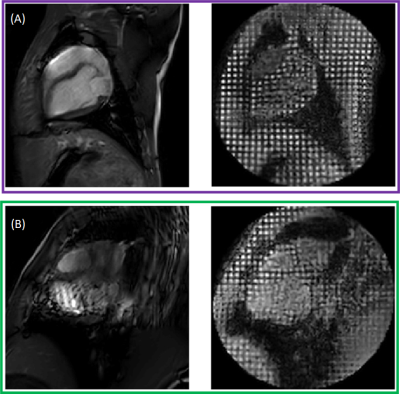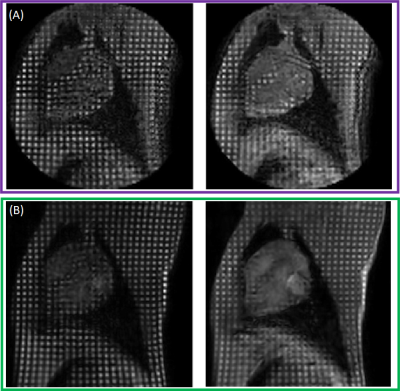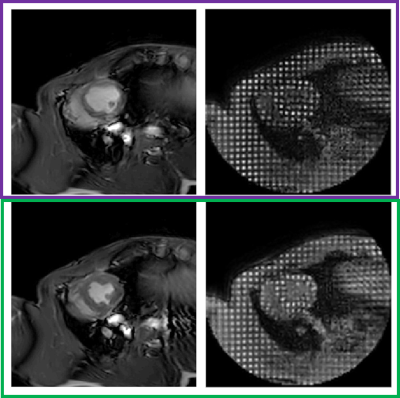1656
An SSFP-SPGR Multi-sequence Cardiac Cine-Tag Acquisition Approach in One Breath-hold1Biomedical Engineering, Illinois Institute of Technology, Chicago, IL, United States, 2Radiology, University of Chicago Medical Center, Chicago, IL, United States, 3Surgery, University of Chicago Medical Center, Chicago, IL, United States, 4Philips, Gainesville, FL, United States, 5Department of Radiology, Cincinnati Children's Hospital Medical Center, Cincinnati, OH, United States, 6Medicine - Cardiology, University of Chicago Medical Center, Chicago, IL, United States
Synopsis
Multi-Contrast single breath-hold acquisition for cardiac MRI is highly desirable but is rate-limited by the need for a dedicated pre-scan per each acquisition. We revisit the notion of the necessary conditions for repeated preparation calibration steps, with the intent of loosening or selectively bypassing them in consecutive scan acquisitions. Under matched geometric conditions that account for sensitivities especially to off-resonance, we propose a simple bSSFP-SPGR based dual-acquisition method with a single intensive Cine calibration followed by a truncated SPGR calibration. This approach is demonstrated as Cine-Tag SSFP-SPGR CMR method that allows for one breath-hold functional acquisition of both scan sequences.
Introduction:
In cardiac MRI (CMR), multi-parametric single breath-hold acquisitions are highly desirable in a fully matched geometry under presence of both respiratory and cardiac motion. However, one of the major rate limiting steps is the need for finely calibrated pre-scan steps per sequence acquisition. Of note, it is known that select sequence families are more susceptible to such calibrations than others to yield robust image output, such as bSSFP Cine (Highly sensitive to off-resonance and signal stability) vs SPGR Tag (Less sensitive) [1]. This trend is more exhibitive at higher field strength imaging.We propose here a joint acquisition of both bSSFP and SPGR contrasts with an overlaid geometry that only requires a single intensive bSSFP pre-scan calibration while truncating the second SPGR pre-scan for full acquisition of two CMR pulse sequences in one breath-hold of under 15 seconds.
In this study, we demonstrate our proof-of-concept bSSFP-Cine + SPGR-Tag CMR approach, for which we examined the extent of required pre-scan calibration times within two ECG R-R intervals, while leveraging dedicated scan-time reduction methods for each sequence.
Methods:
Dual Pulse Sequence Description: Figure 1 shows the schematic of our proposed combined bSSFP-Cine + SPGR-Tag approach, which employed an inverted bSSFP refocusing pulse in the readout direction to enable a pseudo-SPGR contrast, where the readout was also interchangeable with a spiral SPGR scheme. Cine-CMR was obtained with FA = 60o, CS-SENSE and reduced FOV (rFOV = 240mm2) coverage and with default retrospective gating. Two alternative SPGR-Tag schemes were examined: 1. Cartesian with matched CS acceleration(FA = 25o), and 2: optimized Spiral [2] SPGR with FA = 15o. For this joint acquisition, both SPGR-Tag sequences leveraged several superimposed pre-scan calibrations from the initial bSSFP cine.Experiments: Initial testing was performed on two hardwares (Philips Achieva CDAS 1.5T – 2008 model, and Philips Ingenia 3T DDAS – 2016 model), from which we extracted the calibration step duration benchmarks obtained on both systems. Subsequently, the modern 3T system with faster hardware was chosen, in which two sets of n=3 swine subjects with ~30kg (i.e. pediatric) and ~70kg (i.e. adult) were imaged with vastly different anatomy provided off-resonance conditions, including both at pre- and post-contrast injection. The extent of pre-scan ‘recycling’ for the Tagging contrast was examined in this study by employing the deliberate omission of bSSFP F0 and shimming calibrations, thereby allowing for objective examination of the less sensitive SPGR-tag scans. All in-vivo scans were acquired by a technologist blinded to our study design, who was allowed to modify both cine and tag sequence parameters as necessary with the stipulation that geometric parameters needed to be matched. Total breath-hold time was extracted from scanner logging as the duration sum of both acquisitions.
Results
We first report a significant difference in calibration timing performances between the two MRI systems hardware: CDAS (5-7 simulated HB pause between cine and tag) versus DDAS (less than 3 heart beats). On the 2016 DDAS 3T Philips hardware, a previously uncalibrated b-SSFP pre-scan steps required ~18 seconds, which was reduced to ~1.8 seconds when F0 (coarse, fine ~3-4 sec each) and shimming (5.5-8.5 sec) calibrations were bypassed due to parameter recycling. Our subsequent SPGR only required a consistent 730-890 milliseconds (a 20-fold reduction against execution of a dedicated calibration), with an occasional prolonged idle duration of ~1.2 seconds. After accounting for any trigger delays, tag acquisition commenced within 3 R-R after the final cine readout. All dual-sequence scans therefore completed within a single breath-hold. All dual-acquisitions completed within ~14 seconds heart rates between 76 and 116 BPM.When F0 and Automatic Shimming calibrations were deliberately toggled on/off for the examined subjects, we show in Figure 2 that the SPGR-Tag image maintained diagnostic image quality with clearly distinguishable myocardial tags throughout the cardiac cycle despite the significant image quality degradation in matched cine scans.
Figure 3 shows representative dual-sequence tagging reconstructions from Cartesian and Spiral trajectories at both end-systolic and end-diastolic phases of the cardiac cycle with varied dynamics known to affect the prescan calibration steps. Animated Figure 4 shows an example of a combined hybrid reconstruction from the single breath-hold employed previously in [3]. Figure 5 presents an additional representative short-axis scan set at end-Diastole and end-Systole.
Discussions:
We demonstrate the initial feasibility of a single-breath-hold Cine+Tag CMR sequence. Our approach employs a simple concept of making minimal changes to the consecutive sequence acquisition enabled by the combination of refocusing gradient sign reversal (bSSFP to SPGR), and manual programmatic toggle of pre-scan steps, thereby allowing a SPGR tag obtained with bSSFP cine calibration of matched geometry. Unlike previous approaches that enable dual sequence acquisitions using the vendor's proprietary MISS platform [3-5], our method provides a simple workaround approach that overcomes prescan timing constraints, and is highly compatible with existing artifact reduction and scan acceleration techniques such as spiral, CS-SENSE, and rFOV.Acknowledgements
This work has been supported by NIH K25 HL141634 (Kawaji), NIH R01 HL143468 (Hibino), and AHA 19AIREA34450209 (Vaicik).References
1) Hargreaves BA. Rapid gradient-echo imaging. J Magn Reson Imaging. 2012 Dec;36(6):1300-13. doi: 10.1002/jmri.23742. Epub 2012 Oct 23. PMID: 23097185; PMCID: PMC3502662.
2) Pipe, J.G. and Zwart, N.R. (2014), Spiral trajectory design: A flexible numerical algorithm and base analytical equations. Magn. Reson. Med, 71: 278-285. https://doi.org/10.1002/mrm.24675
3) Kawaji K., Nazir N., Narang A., Tani D., Wang H., Smink J., Osman N., and Patel AR. A Single Breath-Hold Simultaneous Acquisition Approach of both Cine-CMR and Strain-Encoded CMR for a Combined Assessment of Myocardial Wall Motion. SCMR 2017. Washington DC. P332.
4) Wang H., Lanier M., Kawaji K., Patel AR., Taylor M., Dumoulin C. Acquisition of bSSFP and Tagged Cines in a Single Breath-Hold for Myocardial Wall Motion Assessment: A Feasibility Study. ISMRM CMR Workshop2017. New York, NY. pp20.
5) Henningsson, M., Mens, G., Koken, P., Smink, J. and Botnar, R.M. (2015), A new framework for interleaved scanning in cardiovascular MR: Application to image-based respiratory motion correction in coronary MR angiography. Magn. Reson. Med., 73: 692-696. https://doi.org/10.1002/mrm.25149
Figures


Figure 2: bSSFP and SPGR pre-scan calibration sensitivity: Comparing A) 2ch Cartesian-Cine Spiral-Tag sequence with F0 and shimming calibrations for the Cine scan and B) 3ch Cartesian-Cine Spiral-Tag without F0 and shimming calibrations. Note that the significant artifacts observed in the 3ch cine do not compromise the subsequent the tagging sequence shown in the green box.


